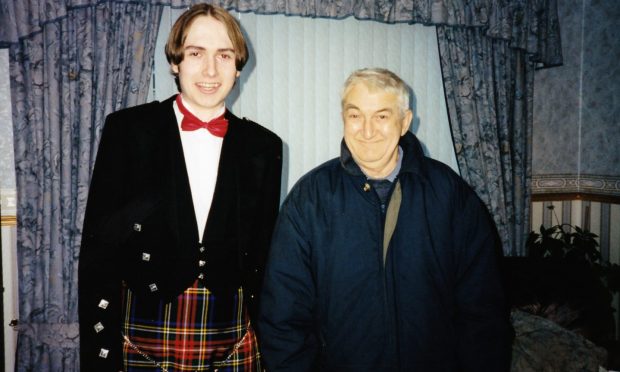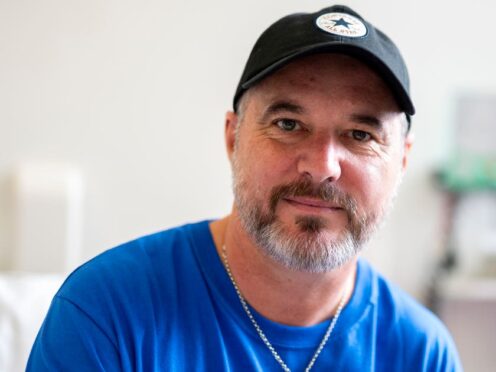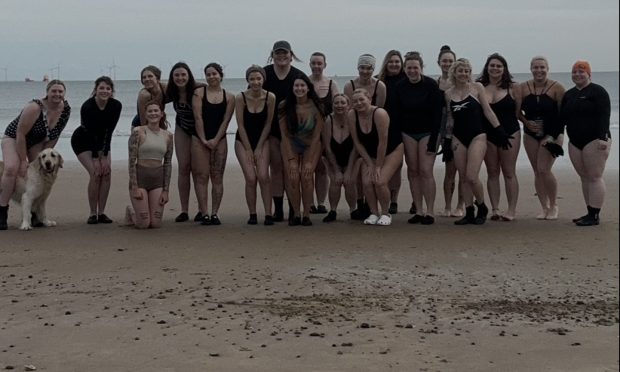It’s only two years since James Rice was diagnosed with the incurable blood cancer myeloma, a condition that at one point withered away his thighbone to the thinness of an aluminium drinks can.
Yet when a Press And Journal reporter calls the 54-year-old retired police officer for a chat he can’t speak because he’s off to play golf.
A few days later, when he is finally pinned down, James proudly recounts a 66-mile charity cycle he completed with his daughter.
What’s going on?
This does not sound like a man struggling to fight a fatal disease. Far less one who underwent chemotherapy and walked with a stick and crutches for a year.
“I’m in a really good place at the moment,” James says as he happily recounts his rounds with friends on golf courses near his home in Dingwall.
The bike ride was back in April when he took part in the Etape Loch Ness. He and his daughter Katie sailed round the course despite heavy rain and wind.
His health is the result of hard work in the physio room and a positive attitude. The golf helps too, not just to keep him mobile but as a way to reconnect with friends.
As James puts it: “Everything’s gone as well as I could have hoped for.”
But behind the positivity, James knows his life will change. While the symptoms of myeloma can be controlled with the right treatment, the cancer remains incurable.
“It will return at some point,” he says.
A sore hip, then a race to save his leg
Before he was diagnosed with it, James had never heard of myeloma.
The disease, which affects 2,000 people in Scotland, first made itself known in 2021 by way of a nagging hip pain that James initially put down to a sports injury.
The keen walker and cyclist had been in Skye with his wife the previous November and though they hadn’t tackled any of the big hills he assumed the pain was connected to that.
But the pain got worse, and eventually a physiotherapist he was seeing suggested talking to a GP.
James was quickly referred for an X-ray, but a five-week waiting list through the NHS meant he went to Glasgow to have it done privately.
He was glad he did. His orthopedic surgeon told him there was nothing wrong with his hip, but that he’d better take a look at the X-ray of his leg.
“I was looking at the two bones and one was white and the other one was white,”” James says. “But there was a big black hole in the middle.
The blood cancer had eaten right through James’ thigh bone, leaving just a sliver of bone around the edge. The only bone left was the thickness of a can of Coke.
The surgeon immediately referred James for an operation to insert a pin in his leg, warning him that putting any weight on it could cause it to snap.
Suddenly feeling extremely fragile, James was given a pair of crutches and driven back to Inverness by his wife.
“It was a real shock,” James says of the moment. “I was going down there thinking, I’m going to get some answers. I’m going to get on some physio programme or whatever I needed to get back to normal. And then, oh, actually, it’s something far more sinister.”
What is myeloma, and what are the symptoms?
James was in Raigmore Hospital for a couple of weeks. The stay was during lockdown so he was cut off from friends and family, a situation he says was the biggest ordeal of all.
Eventually, a straight-talking Dutch doctor told him he had myeloma.
However, as James learned more about the disease, which develops from plasma cells in the bone marrow, he realised that in terms of the cancer lottery he had a decent ticket.
“The average [life expectancy] is maybe 10 years,” James says. “I’d just lost a friend not that long ago to pancreatic cancer, and that was one of those four-month scenarios. So obviously I was thankful that I was getting more time.”
James has made the most of his time so far.
After going through chemotherapy and a stem-cell transplant in October 2021, it took him about a year to recover.
But once through the physiotherapy, he was back on the golf course, and spending time with daughter Katie and sons Daniel and Joe.
The hole in his thighbone has gone – the bone has regrown around the metal pin. It means he no longer has to walk with crutches or a stick, or worry about his leg snapping off.
He also tries to raise awareness of myeloma. Despite being the third-most common type of blood cancer, myeloma is frequently missed.
Symptoms such as back pain and fatigue are often linked to ageing or minor conditions.
Covid-19 saw a drop in diagnoses. According to charity Myeloma UK, this means hundreds of people could be unaware they are living with the blood cancer.
“It’s like any disease,” James says. “If your body’s got symptoms, it’s for a reason. So you’ve got to get to the bottom of it.”
Making the most of the time he has left
The myeloma may still hang over him, but James says he’s achieved a level of normalcy in his life that he’s grateful for.
“It’s a case of, today I’m healthy and happy, so get on with it,” he says. “Don’t worry about whether it’s two months, three months, one year, two year – you just don’t know.
“There isn’t a definitive time period. I might get five years, I might get 10 years, I might get 15. It’s a case of hoping that I’m one of the fortunate ones that lasts quite long.”














